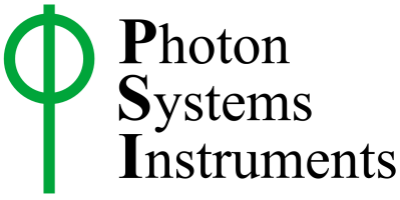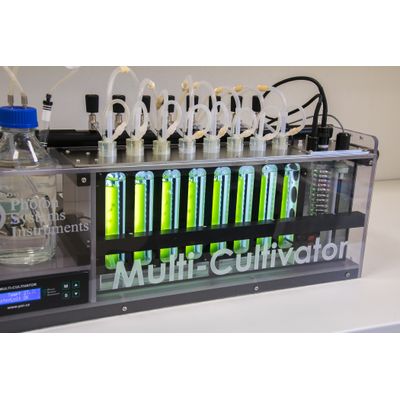

- Home
- Companies
- Photon Systems Instruments, spol. s r.o ...
- Products
- PSI - Model MC 1000-OD - ...

PSI - Model MC 1000-OD - Multi-Cultivator Photobioreactor
Multi-Cultivator MC 1000-OD is intended for small-scale screening experiments of phototrophic organisms as algae, cyanobacteria and plant cells. Also other microorganisms, for example heterotrophic bacteria and yeast grown in suspension, may enjoy this type of cultivator. The special design of the instrument allows to run fast comparison studies of various organisms, mutants or cultivation conditions.
- Cultivation of autotrophic and heterotrophic microorganisms grown in suspension
- Parallel or multi-variant screening experiments in 8 independent vessels
- Independent illumination and OD monitoring (680 and 720 nm) for each vessel
- Standard white LED illumination
- Color illumination in multi- or mix- version (up to 8 colors
- in each cultivation slot)
- Uniform temperature and aeration control for all vessels
- Various cultivation strategies (batch, turbidostatic)
- Online software control
- 8 round glass testing tubes, each holding up to ca. 80 ml of cultivated suspension. The tube diameter is 27 mm.
- Silicone inert stopper with aeration input and waste output.
- Glass Aeration Tubes (standard) or Stainless-Steel Aeration Tubes (optional) that are easier and safer in manipulation.
- Autoclavable design.
- Humidifier for a moistening of the sparging air to avoid an increased medium evaporation from the testing tubes.
- Three-Way Sampling Valve (optional) for culture sampling through the aeration tubing. Non-autoclavable.
- Thermostated waterbath nesting 8 testing tubes.
- Temperature range:
- • 15 – 60 °C with the Cooling Unit AC-710 (optional).
- Homogeneous temperature among all tubes and also in their vertical profile is ensured by the immersion of the whole tubes in the waterbath and by sufficient water mixing.
- PWM Pump for an automatic water refilling into the thermostated waterbath during the high-temperature or long-term cultivation (optional).
- LED technology.
- Illumination is independently adjustable for each testing tube in intensity, timing and modulation.
- Illumination up to 1.000 µmol.m-2.s-1 (optionally up to 2.500 µmol.m-2.s-1 with the Light Upgrade - only for white versions).
- Single color version: cool white (standard); warm white, 450, 475, 530, 615, 660, 730 nm (optional)
- Multi-color version (single color slots): 405, 450, 475, warm white, 530, 615, 660, 730 nm. Intensity: up to 1.000 µmol.m-2.s-1
- Mix-color version (mixed color slots): 405, 450, 475, warm white, 530, 615, 660, 730 nm. Intensity: up to 2.500 µmol.m-2.s-1 , i.e. around 300 µmol.m-2.s-1 per color per slot. Warm white color is represented by two LED circuits and thus the intensity of warm white goes up to 600 µmol.m-2.s-1 per color per slot.
- Constant light conditions or the alternation of various light and dark cycles.
- The duration of the individual cycles: from minutes up to days.
- The mode of the light cycles: constant, linear increase or decrease, sinusoid mode for simple imitation of diurnal rhythms. Moreover, java scripting is incorporated in the Photobioreactor Control Software (advanced version, optional) for a creation of the advanced light protocols (for example automatic light intensity adjustment in dependence on the actual biomass concentration).
- Protective Front Cover that prevents cultivated samples to be influenced by an unwanted external light (sunshine etc.).
- Aeration system provides sufficient mixing and also air/CO2 supply to cultures across the entire water column.
- The air source: a small aeration pump providing total air flow rate around 1.100 ml / min.
- Manually adjustable valve manifold that distributes the air into individual testing tubes.
- Glass Aeration Tubes (standard) or Stainless-Steel Aeration Tubes (optional) that are easier and safer in manipulation.
- The aeration is interrupted during the OD measurement automatically to avoid interference of the aeration bubbles with the OD measurement. The release of the residual air from the system is facilitated by the inbuild backpressure valve.
- Incorporated module for connection of the compressed air/gas through Parker Prestolok (6 mm) connector.
- Optionally, Multi-Cultivator can be linked to the Gas Mixing System GMS 150 that provides precise concentration and flow rate of the required gases. For more information see our website about the Gas Mixing System GMS 150.
- OD 680 and 720 nm are measured automatically and independently for each testing tube.
- The optical path of the measurement is 27 mm.
- OD 720 measures light scattering on particles and can serve as a proxy for biomass growth whereas OD 680 is linked to the chlorophyll absorption and can be used for an estimation of chlorophyll concentration.
- The optical density is periodically measured and the data are stored in the Multi-Cultivator internal memory. Stored data may later be downloaded to a PC and displayed in graphs or exported to TXT or Excel files via the provided OD View program.
- Moreover, the Photobioreactor Control Software (optional) enables remote online visualization of recorded data in real-time. The software allows to fit the OD data with the various regression functions to facilitate the evaluation of the actual growth rate.
- Turbidostatic Module (optional): controls the biomass concentration (turbidity) via OD 680 or OD 720 in each vessel independently. The OD can be maintained at a constant level or within a preset range depending on the experimental aim.
- Special silicon stoppers with an additional port for medium fed in.
- The flow rate of the peristaltic pump feeding in the medium runs between 0.2 – 50 ml/min and is adjustable for each test vessel independently. Just one medium reservoir for all cultivation vessels can be used.
- Culture volume is kept constant by a passive medium overflow.
- The module includes its own aeration pump that is more powerful compared to the standard air pump and thus can provide sufficient power to aerate the entire system properly.
- The Photobioreactor Control Software must be ordered to operate the Turbidostatic module.
Optionally, the entire Multi-Cultivator system and all its cultivation and monitoring functions (light, temperature, optical density, turbidostatic cultivation, and aeration gas) can be controlled via the Photobioreactor Control Software. The control software provides intuitive and dynamic interface for online monitoring and visualization of all measured data as well as creation of user-defined protocols.
- High-throughput screening in multi-tubes experimental design
- Bioprospecting of natural populations
- Different organisms and mutants testing and comparing
- Optimization of diverse cultivation conditions as nutrients, illumination, etc.
- Regulatory profiling of algae
- Growth dynamics monitoring
- Optimizing yield of end-product
- Toxicity tests
